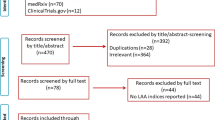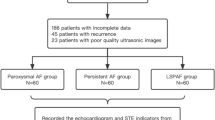Abstract
The anatomical and functional characteristics of the left atrial appendage (LAA) and its relationships with anatomical remodeling and ischemic stroke in patients with atrial fibrillation (AF) have not been clearly established. The purpose of this study was to determine whether functional and morphological features of the LAA independently predict clinical outcome and stroke in patients with AF who underwent catheter ablation (CA). Two hundred sixty-four patients with AF, including 176 with paroxysmal AF (PAF, 54.0 ± 11.4 years old, M:F = 138:38) and 88 with persistent AF (PeAF, 56.4 ± 9.6 years old, M:F = 74:14) were studied. Of these patients, 31 (11.7 %) had a history of stroke/TIA (transient ischemic attack). The LA and LAA volumes were 124.0 ± 42.4 and 24.9 ± 4.3 ml in PeAF, these values were greater than those in PAF (81.2 ± 24.8 ml and 21.2 ± 5.1 ml, P < 0.001). The AF type (P = 0.016) and AF duration (P = 0.005), and anti-arrhythmic drugs use (P < 0.001) were significant predictors of AF recurrence after CA in all patients. Compared with patients without history of stroke, stroke patients had larger LA volume (106.9 ± 23.0 vs. 94.0 ± 38.9 ml, P = 0.004) and had lower LAA EF (50.0 ± 11.0 vs. 65.7 ± 13.4 %, P < 0.001). The independent predictors of stroke were age (P = 0.002) and LAA EF (P < 0.001) in PAF patients and that was only age (P = 0.001) in PeAF patients. In anatomical and morphological parameters of the LA and LAA, only depressed systolic function of the LAA was significantly related to stroke/TIA and recurrence of AF after CA in paroxysmal AF patients. Further large scaled prospective study is required for validation.




Similar content being viewed by others
References
Anderson RH, Razavi R, Taylor AM (2004) Cardiac anatomy revisited. J Anat 205(3):159–177
Chang SH, Tsao HM, Wu MH et al (2007) Morphological changes of the left atrial appendage after catheter ablation of atrial fibrillation. J Cardiovasc Electrophysiol 18(1):47–52
Corradi D, Callegari S, Benussi S et al (2005) Myocyte changes and their left atrial distribution in patients with chronic atrial fibrillation related to mitral valve disease. Hum Pathol 36(10):1080–1089
Daoud EG, Weiss R, Bahu M et al (1996) Effect of an irregular ventricular rhythm on cardiac output. Am J Cardiol 78(12):1433–1436
Shinbane JS, Wood MA, Jensen DN, Ellenbogen KA, Fitzpatrick AP, Scheinman MM (1997) Tachycardia-induced cardiomyopathy: a review of animal models and clinical studies. J Am Coll Cardiol 29(4):709–715
Wolf PA, Abbott RD, Kannel WB (1991) Atrial fibrillation as an independent risk factor for stroke: the Framingham Study. Stroke 22(8):983–988
Fuster V, Ryden LE, Cannom DS et al (2006) ACC/AHA/ESC 2006 guidelines for the management of patients with atrial fibrillation: a report of the American College of Cardiology/American Heart Association Task Force on practice guidelines and the European Society of Cardiology Committee for practice guidelines (Writing Committee to revise the 2001 guidelines for the management of patients with atrial fibrillation): developed in collaboration with the European Heart Rhythm Association and the Heart Rhythm Society. Circulation 114(7):e257–e354
Lo LW, Tai CT, Lin YJ et al (2009) Predicting factors for atrial fibrillation acute termination during catheter ablation procedures: implications for catheter ablation strategy and long-term outcome. Heart Rhythm 6(3):311–318
Berruezo A, Tamborero D, Mont L et al (2007) Pre-procedural predictors of atrial fibrillation recurrence after circumferential pulmonary vein ablation. Eur Heart J 28(7):836–841
Qamruddin S, Shinbane J, Shriki J, Naqvi TZ (2010) Left atrial appendage: structure, function, imaging modalities and therapeutic options. Expert Rev Cardiovasc Ther 8(1):65–75
Calkins H, Brugada J, Packer DL et al (2007) HRS/EHRA/ECAS expert consensus statement on catheter and surgical ablation of atrial fibrillation: recommendations for personnel, policy, procedures and follow-up. A report of the Heart Rhythm Society (HRS) Task Force on catheter and surgical ablation of atrial fibrillation. Heart Rhythm 4(6):816–861
Natale A, Raviele A, Arentz T et al (2007) Venice Chart international consensus document on atrial fibrillation ablation. J Cardiovasc Electrophysiol 18(5):560–580
Pollak A, Falk RH (1995) Aggravation of postcardioversion atrial dysfunction by sotalol. J Am Coll Cardiol 25(3):665–671
Wang Y, Di Biase L, Horton RP, Nguyen T, Morhanty P, Natale A (2010) Left atrial appendage studied by computed tomography to help planning for appendage closure device placement. J Cardiovasc Electrophysiol 21(9):973–982
Beinart R, Heist EK, Newell JB, Holmvang G, Ruskin JN, Mansour M (2011) Left atrial appendage dimensions predict the risk of stroke/TIA in patients with atrial fibrillation. J Cardiovasc Electrophysiol 22(1):10–15
Pollick C, Taylor D (1991) Assessment of left atrial appendage function by transesophageal echocardiography. Implications for the development of thrombus. Circulation 84(1):223–231
Sahin T, Ural D, Kilic T et al (2009) Evaluation of left atrial appendage functions according to different etiologies of atrial fibrillation with a tissue Doppler imaging technique by using transesophageal echocardiography. Echocardiography 26(2):171–181
Fleming HA, Bailey SM (1971) Mitral valve disease, systemic embolism and anticoagulants. Postgrad Med J 47(551):599–604
Neilson GH, Galea EG, Hossack KF (1978) Thromboembolic complications of mitral valve disease. Aust N Z J Med 8(4):372–376
Al-Saady NM, Obel OA, Camm AJ (1999) Left atrial appendage: structure, function, and role in thromboembolism. Heart 82(5):547–554
Kamp O, Verhorst PM, Welling RC, Visser CA (1999) Importance of left atrial appendage flow as a predictor of thromboembolic events in patients with atrial fibrillation. Eur Heart J 20(13):979–985
Choudhury A, Lip GY (2003) Atrial fibrillation and the hypercoagulable state: from basic science to clinical practice. Pathophysiol Haemost Thromb 33(5–6):282–289
Heppell RM, Berkin KE, McLenachan JM, Davies JA (1997) Haemostatic and haemodynamic abnormalities associated with left atrial thrombosis in non-rheumatic atrial fibrillation. Heart 77(5):407–411
Leithauser B, Park JW (2009) Cardioembolic stroke in atrial fibrillation-rationale for preventive closure of the left atrial appendage. Korean Circ J 39(11):443–458
Ernst G, Stollberger C, Abzieher F et al (1995) Morphology of the left atrial appendage. Anat Rec 242(4):553–561
Shirani J, Alaeddini J (2000) Structural remodeling of the left atrial appendage in patients with chronic non-valvular atrial fibrillation: implications for thrombus formation, systemic embolism, and assessment by transesophageal echocardiography. Cardiovasc Pathol 9(2):95–101
Parikh SS, Jons C, McNitt S, Daubert JP, Schwarz KQ, Hall B (2010) Predictive capability of left atrial size measured by CT, TEE, and TTE for recurrence of atrial fibrillation following radiofrequency catheter ablation. Pacing Clin Electrophysiol 33(5):532–540
von Bary C, Dornia C, Eissnert C et al (2012) Predictive value of left atrial volume measured by non-invasive cardiac imaging in the treatment of paroxysmal atrial fibrillation. J Interv Card Electrophysiol 34(2):181–188
(2007) Independent predictors of stroke in patients with atrial fibrillation: a systematic review. Neurology 69(6):546–554
(1996) Silent brain infarction in nonrheumatic atrial fibrillation. EAFT Study Group. European atrial fibrillation trial. Neurology 46(1):159–165
Das RR, Seshadri S, Beiser AS et al (2008) Prevalence and correlates of silent cerebral infarcts in the Framingham offspring study. Stroke 39(11):2929–2935
Conflict of interest
None.
Author information
Authors and Affiliations
Corresponding author
Rights and permissions
About this article
Cite this article
Park, HC., Shin, J., Ban, JE. et al. Left atrial appendage: morphology and function in patients with paroxysmal and persistent atrial fibrillation. Int J Cardiovasc Imaging 29, 935–944 (2013). https://doi.org/10.1007/s10554-012-0161-y
Received:
Accepted:
Published:
Issue Date:
DOI: https://doi.org/10.1007/s10554-012-0161-y




